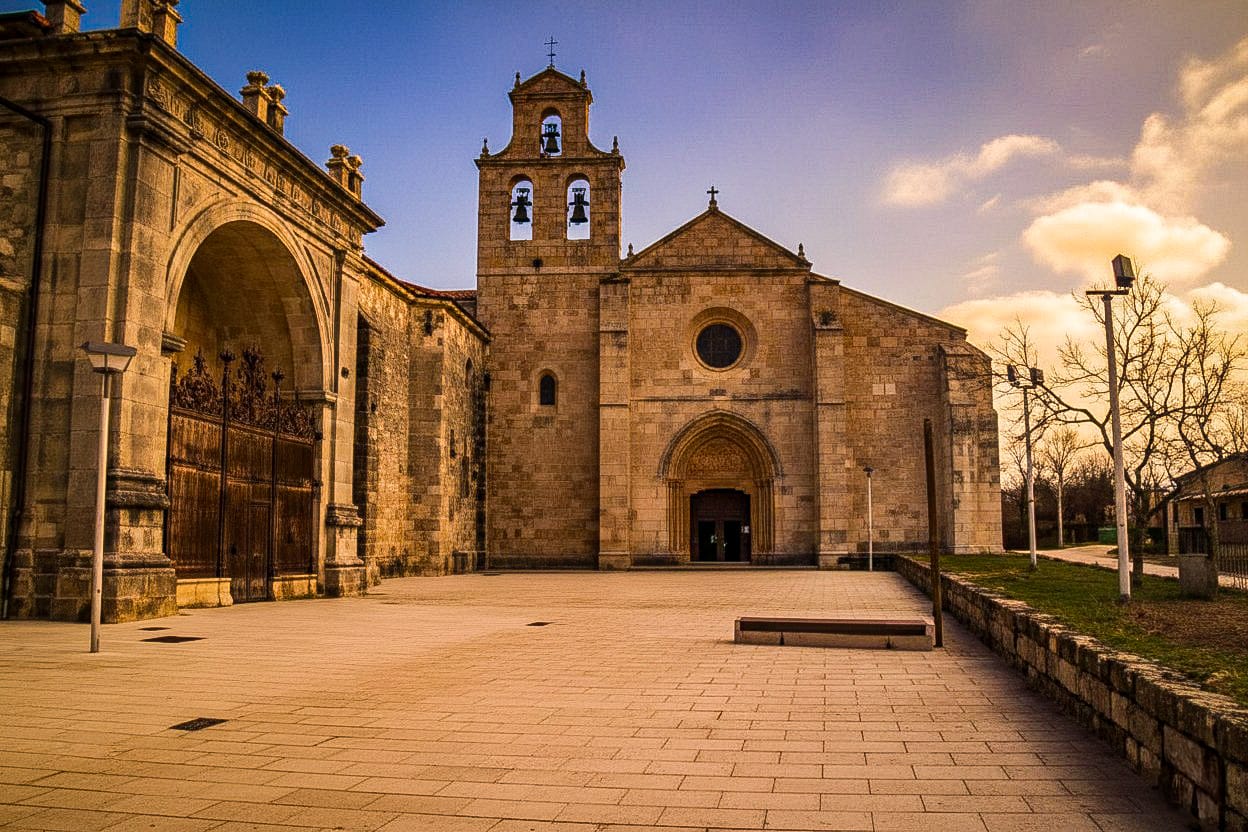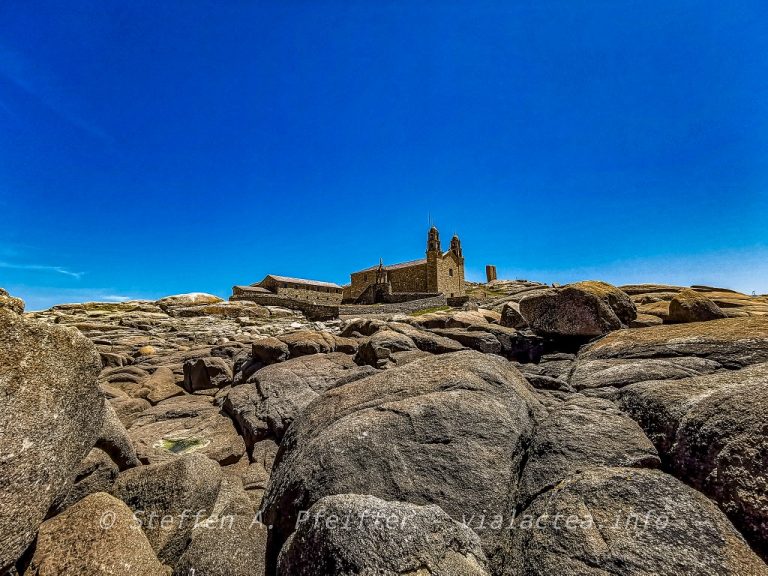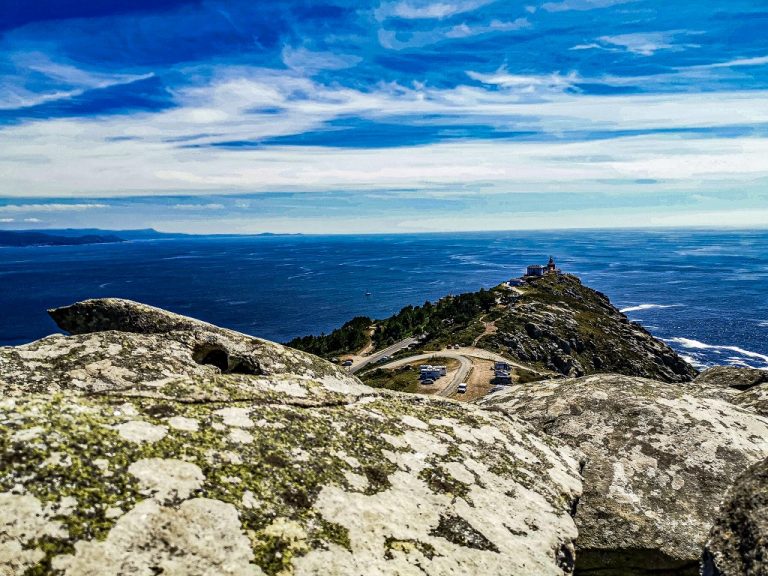
A New Stage Day – Beginning & Atmosphere
The morning in Belorado awakens in gentle light. On the Plaza Mayor, the first locals are already sitting with their coffee, while pilgrims quietly shoulder their backpacks. Once more, the scent of freshly baked bread drifts through the streets, once more the murmur of the Río Tirón accompanies you – then the Camino leads you out of town.
Ahead lies a stage that rises from a gentle course through villages up into the ancient Montes de Oca – a landscape that has shaped pilgrims for centuries, whose forests and stones tell stories that go far beyond the measure of humankind.

Route & Elevation Profile
- Distance: approx. 24–24.5 km
- Elevation: +440–473 m / –200–236 m
- Difficulty: medium – the climb after Villafranca is the real challenge; the rest runs along quiet paths.
The day demands less physical toughness than inner endurance. Wide fields, small villages, then forest: the stage changes like a musical score between calm and powerful passages.
Variants & Small Detours
The main route leads directly from Belorado to San Juan de Ortega. Alternatives go through Agés or Atapuerca – places that offer flexibility for a different stage plan. Yet most pilgrims follow the classic course: through the Montes de Oca, into the silence that for centuries has been regarded as a test of spirit.

Description of the Way – With All Senses
Beyond Belorado you first follow the N-120, before the Camino takes you across a wooden bridge over the Río Tirón. Your gaze drifts back to the medieval stone arch glimmering in the morning light, then the fields open up. Soon, above the village of Tosantos, rises the Ermita Virgen de la Peña. Carved high into the rock, it watches over the valley. The Virgin has been venerated here for centuries, and even today, on September 9, the villagers carry her in a solemn procession up to the chapel. The sight of this rock-hewn church is a quiet miracle – a place where landscape and faith become one.
In Villambistia, the fountain greets you with its four jets, whose water, according to tradition, grants strength and healing. Right beside it lies the Bar San Roque, where a coffee, a glass of water, and a kind word give new energy.
Shortly afterwards, you reach Espinosa del Camino. The small parish church of the Assumption of Mary holds a splendid Renaissance chapel with a star vault, built in 1544 by Juan de Landeras and Juan de Carasa. Its construction cost 40,000 maravedís – a fortune for a village of that size. Among the old half-timbered houses you feel how rural architecture still lives here. Just beyond the village, the ruins of the Monastery of San Felices appear. Only one apse rises into the sky, yet it tells a great story: Count Diego Rodríguez Porcelos, founder of the city of Burgos, is said to be buried here. In 1409, the Mozarabic community that lived here was incorporated into the Monastery of San Millán de la Cogolla. A venerable, quiet place that inevitably invites you to linger.
Then you reach Villafranca Montes de Oca, once an episcopal seat, now a small village with a hospital, bars, shops, and hostels. Here the plain ends – and the ascent begins. Yet just beyond the village, a special sight opens up: the Presa de Alba, a silent reservoir on the Río Oca, nestled between forest and rock. A place not only of calm, but where the earth itself reveals its story: the surrounding rock formations are over 500 million years old. They originate from the depths of the Iberian Massif and remind us that this Camino leads not only through centuries of human history but also through millions of years of the earth’s evolution.
With this awareness in your heart begins the true ascent: 200 meters of elevation through the Montes de Oca. The Mojapán spring trickles beside the path; later, a memorial recalls the victims of the Civil War. Pines and oaks provide shade, resin fills the air, and only the crunch of your steps and the rustling of the wind accompany you. Here, where once bandits threatened pilgrims, there now reigns the silence of the forest – a silence that tests and transforms you.
Finally, the forest clears. Ahead lies San Juan de Ortega, the Romanesque monastery of the holy companion of Santo Domingo. Its centerpiece is the church with the famous miracle of light: at the equinox, a single ray of sunlight falls on the capital of the Annunciation – a harmony of architecture and cosmos that unites heaven and earth. A quiet, sacred place where you inevitably join the chain of countless pilgrims who have paused here through the ages.

Intermediate Places & Highlights
| Tosantos | approx. 5 km | Ermita Virgen de la Peña | Raise your gaze to the rock |
| Villambistia | approx. 7 km | Fountain, Bar, Church of San Esteban | Rest and recharge |
| Espinosa del Camino | approx. 9 km | Church, half-timbered houses, Monastery of San Felices | Pause for history |
| Villafranca Montes de Oca | approx. 12 km | Hospital, bars, starting point of ascent | Refill provisions |
| Presa de Alba | approx. 13–14 km | Reservoir, geological formations, 500-million-year-old rocks | Experience Earth’s history |
| Montes de Oca – Forest | approx. 20 km | Pines, Mojapán spring, memorials | Experience nature with all senses |
| San Juan de Ortega | approx. 24 km | Romanesque monastery, miracle of light | Arrival full of spirituality |

Packing & Supply Tips
- Supplies: Bars in Tosantos, Villambistia, Espinosa, and Villafranca. Afterwards, no further possibility for a long stretch.
- Tip: Refill water and provisions in Villafranca – for the forest section and a possible rest at the Presa de Alba.
- Bring along: sun hat, warm layer for the forest, trekking poles for the ascent.
Food, Accommodation & Supply
- Tosantos: Parroquial Albergue San Francisco de Asís (donativo)
- Villambistia: Albergue San Roque
- Espinosa: Casa Las Almas, Albergue La Taberna
- Villafranca: Historic Albergue San Antón Abad, municipal hostel
- San Juan de Ortega: Monastery hostel, small guesthouses, Albergue El Descanso
What Makes This Day Special
The stage is a path of transitions: from fields to villages, from springs to monastery ruins, from human history to earth history. At the Presa de Alba, stones millions of years old merge with the present pilgrimage – and at the end, San Juan de Ortega unites heaven and earth in the miracle of light.
Reflection at the End of the Stage
When you stand in the monastery courtyard, surrounded by woods and stones older than any pilgrimage tradition, you may ask yourself: “What carries me more – the stories of people or the voices of the earth that have spoken here since the beginning of time?”
📊 Tabular Overview
| 12 | Belorado | San Juan de Ortega | approx. 24 km | +440–473 m / –200–236 m | medium | Tosantos, Villambistia, Espinosa, Villafranca, Presa de Alba, Montes de Oca, San Juan de Ortega |
🌌 Camino of the Stars
Belorado → Tosantos → Villambistia → Espinosa del Camino → Villafranca Montes de Oca → Presa de Alba → Montes de Oca → San Juan de Ortega
Has this stage inspired you? Or have you already visited the Presa de Alba and gathered your own impressions? Share your experiences – every voice makes the Camino come alive.



